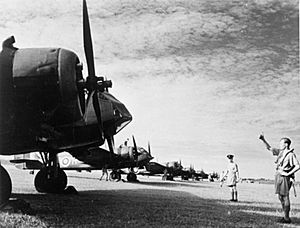Patrick Stanley Vaughan Heenan facts for kids
Quick facts for kids
Patrick Stanley Vaughan Heenan
|
|
|---|---|
 |
|
| Born | 29 July 1910 Reefton, New Zealand |
| Died | 13 February 1942 (aged 31) Keppel Harbour, Singapore |
| Cause of death | Execution |
| Allegiance | |
| Service/ |
|
| Years of service | 1932–1942 |
| Rank | Captain |
| Unit | 16th Punjab Regiment Indian Army Service Corps 300 Air Liaison Section, Malaya |
| Battles/wars | World War II |
Patrick Stanley Vaughan Heenan (born 29 July 1910 – died 13 February 1942) was a captain in the British Indian Army. He was found guilty of helping Japan by secretly sharing information during World War II. This happened during the Malayan campaign. Heenan was later killed while he was being held captive during the Battle of Singapore. Many details about these events were kept secret by British officials at the time.
Contents
Early Life and School
Patrick Heenan was born in Reefton, New Zealand, on 29 July 1910. His mother, Anne Stanley, was not married when he was born. A year later, Patrick and his mother moved to Burma with a mining engineer named George Charles Heenan. Patrick was baptized as a Roman Catholic and given the last name Heenan.
In 1922, Patrick and his mother moved to England. From 1923 to 1926, Patrick attended Sevenoaks School in Kent. In 1927, he went to Cheltenham College. Heenan was not a strong student and sometimes struggled to fit in with other pupils.
However, he was very good at sports, especially boxing, because he was strong. Heenan joined the Officers Training Corps (OTC) at Cheltenham. But he did not get the formal grades needed to join the regular British Army officer training. So, at age 19, he started working for a trading company called Steel Brothers in Asia.
Becoming an Army Officer
In the early 1930s, Heenan found a special way to become an officer. He joined the Army Supplementary Reserve. This allowed him to become an officer even without the usual formal qualifications. He used his baptism certificate and a note from his school headmaster to prove he could do the job.
In 1932, he joined this reserve group. By 1935, he officially became an officer in the British Army. He was sent to India. After some training, he joined the 16th Punjab Regiment. Heenan later moved to the Indian Army Service Corps, but then returned to a different part of the 16th Punjabs.
In 1938–1939, Heenan took a six-month break, which was common in the Indian Army. He spent this time in Japan.
War in Malaya
In 1941, people worried that Japan might attack Southeast Asia. Heenan's unit was sent to Malaya. He was then moved to an Indian Army Air Liaison Unit and went to Singapore for training. After his training, Heenan was stationed at Alor Setar in northern Malaya in June 1941. This area was where many British, Australian, and New Zealand air force planes were based.

On 8 December, Japanese forces attacked Thailand and Malaya. People noticed that Japanese planes seemed to know the secret codes used by the Allies. By 10 December, the Japanese had destroyed most of the Allied aircraft in northern Malaya.
Heenan was caught during an air raid. Soldiers became suspicious when he was not in the trenches with them. They found a warm radio in his room. Heenan was arrested. It was believed that he had been sending radio messages to help the Japanese air raids. He reportedly had a special radio hidden as a typewriter.
Heenan was sent to Singapore and faced a military trial in January 1942. He was not formally sentenced, but helping an enemy country during wartime usually meant a death sentence for British officers.
His Death
Heenan stayed in custody in Singapore for several weeks. The Japanese forces slowly pushed the Allies out of Malaya. On 8 February, they attacked Singapore Island. It soon became clear that the Japanese would win the battle.
By 13 February, Heenan was reportedly acting very confident. He was teasing his guards, saying he would soon be free and they would be prisoners. It seems that British military police decided to take action. Heenan was reportedly taken to the dockside at Keppel Harbour. A sergeant shot him, and his body was put into the harbor.
What Happened After
Military experts believe that Heenan's actions did not cause the Allies to lose the war. However, he likely caused No. 62 Squadron to lose some planes and people. Some historians suggest that the British air forces might have been defeated anyway. Their planes in Malaya were not as good as Japan's, and their airfields were hard to defend.
Heenan's actions spread quickly among British officers. This had a big effect on how they felt about the war.
By 1998, families of other soldiers who died in World War II wanted Heenan's name removed from the Commonwealth War Graves Commission memorial in Singapore. His death date on the memorial, 15 February 1942, was a common date given to all soldiers missing during the Battle of Singapore.
See also
- Velvalee Dickinson (American spy for Japan during World War II)
- John Semer Farnsworth (American spy for Japan in the 1930s)
- Harry Thompson (spy) (American spy for Japan in the 1930s)
- Norman Baillie-Stewart (British spy for Germany during World War II)
- Arthur Owens (suspected British spy for Germany during World War II)
- Eddie Chapman (British double agent during World War II)
- William Colepaugh (American spy for Germany during World War II)
- Tyler Kent (American spy for Germany in the early 1940s)

